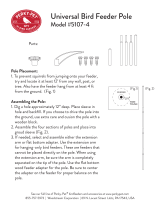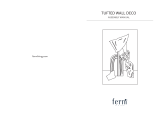Page is loading ...

While most wild birds
rely on wild foods for the
bulk of their meals, more
than 100 North American
species supplement natural
foods with birdseed, suet,
fruit, and nectar obtained
from feeders. Bird feeding
can benefit birds while
also providing pleasure
for people throughout the
year. Feeders benefit birds
most during the winter,
when natural food supplies
are scarce. However,
additional species visit
feeders during spring and
fall migrations, and some
nesting birds utilize feeders
during the summer.
Audubon Guide
to Bird Feeding
How to attract birds to
your feeders
LIKE US, BIRDS NEED FOOD, WATER,
AND SHELTER
To keep birds coming back to your feeders, provide
them with three essential elements: the right variety of
quality seed, a source of fresh water for drinking and
bathing, and ample cover, preferably provided by native
plants. Native plants also provide potential nesting sites
and a source of natural food. Bird feeders can present
some risks, potentially increasing the chances of win-
dow collisions, predation, and exposure to disease.
LOCATE FEEDERS AT DIFFERENT LEVELS
Sparrows, juncos, and towhees usually feed on the
ground, while finches and cardinals feed in shrubs, and
chickadees, titmice, and woodpeckers feed in trees. To
avoid crowding and to attract the greatest variety of
species, provide table-like feeders for ground-feeding
birds, hopper or tube feeders for shrub and treetop
feeders, and suet feeders well o the ground for wood-
peckers, nuthatches, and chickadees.
OFFER DIFFERENT SEEDS IN DIFFERENT FEEDERS
A variety of seeds will attract the greatest variety of birds.
To avoid waste, oer dierent seeds in dierent feeders.
Black-oil sunflower seed appeals to the greatest number
of birds. Oer sunflower seeds, Nyjer® (thistle) seeds, and
peanuts in separate feeders. When using blends, choose
mixtures containing sunflower seeds, millet, and cracked
corn—the three most popular types of birdseed. Birds
that are sunflower specialists will readily eat the sun-
flower seed and toss the millet and corn to the ground,
to be eaten by ground-feeding birds such as sparrows
and juncos. Mixtures of peanuts, nuts, and dried fruit
are attractive to woodpeckers, nuthatches, and titmice.
Relatively few species prefer milo, wheat, and oats, which
are featured in less expensive blends.
QUICK TIPS
BIRD FEEDING BASICS
Written by Stephen W. Kress, PhD
Cover, clockwise from top left: Camilla
Cerea/Audubon; Northern Cardinal.
Photo: chas53/Adobe Stock; Mike
Fernandez/Audubon; Camilla Cerea/
Audubon; Mike Fernandez/Audubon;
Tufted Titmouse. Photo: chas53/Adobe
Stock. Inside: Tufted Titmouse. Photo:
Steve Byland/Adobe Stock
225 Varick Street
New York, NY 10014
844.428.3826
Visit Audubon online for
more information and tips on
creating a bird-friendly yard.
www.audubon.org
About Audubon
The National Audubon Society protects birds and the
places they need, today and tomorrow. Audubon works
throughout the Americas using science, advocacy,
education, and on-the-ground conservation. State
programs, nature centers, chapters, and partners
give Audubon an unparalleled wingspan that reaches
millions of people each year to inform, inspire, and unite
diverse communities in conservation action. A nonprofit
conservation organization since 1905, Audubon believes
in a world in which people and wildlife thrive.

Homemade recipes to
add to your bird feeders
SUET FEEDING
Suet (beef fat) attracts insect-eating birds such as
woodpeckers, wrens, chickadees, nuthatches, and titmice.
Place the suet in special feeders or net onion bags at
least five feet above the ground to keep it out of the
reach of dogs, squirrels, etc. Although suet is particularly
helpful during cold weather and migration, when birds
need extra fat reserves, “no melt” suet cakes are now
available for use in warmer weather.
MIX PEANUT BUTTER AND CORNMEAL
Peanut butter is a good substitute for suet in the summer.
Mix one part peanut butter with five parts cornmeal and
stu the mixture into holes drilled in a hanging log or into
the crevices of a large pine cone. This all-season mixture
attracts woodpeckers, chickadees, titmice, and occasion-
ally warblers.
PROVIDE FRUIT FOR BERRY-EATING BIRDS
Fruit specialists such as robins, waxwings, bluebirds,
and mockingbirds rarely eat birdseed. To attract these
birds, soak raisins and currants in water overnight, then
place them on a table feeder, or purchase blends with
a dried fruit mixture. To attract orioles and tanagers,
skewer halved oranges onto a spike near other feeders,
or provide nectar feeders.
PROVIDE NECTAR FOR HUMMINGBIRDS
Make a sugar solution of one part white sugar to four
parts water. Boil briefly to sterilize and dissolve sugar
crystals (no need to add red food coloring). Feeders must
be washed every few days with very hot water and kept
scrupulously clean to prevent the growth of mold.
Keep feathered visitors safe
LOCATE FEEDERS TO REDUCE WINDOW COLLISIONS
In the United States, approximately one billion birds die
from flying into windows each year. Reduce the risk of bird
collisions by placing feeders less than three feet from a
window or more than 30 feet away. Mobiles, opaque deco-
rations, and fruit tree netting outside windows also helps to
deflect birds from the glass.
DISCOURAGE SQUIRRELS FROM CONSUMING
FEEDER FOODS
Squirrels are best excluded by placing feeders on a pole in
an open area. Pole-mounted feeders should be about five
feet o the ground and protected by a cone-shaped bae
(at least 17 inches in diameter) or a similar obstacle below
the feeder. Locate pole-mounted feeders at least 10 feet
from the nearest shrub, tree, or other tall structure. Squirrel
feeders stocked with blends that are especially attractive to
squirrels and chipmunks can reduce competition for high-
priced foods oered at bird feeders. Locate squirrel feeders
far from bird feeders to further reduce competition.
KEEP CATS INDOORS
Cats kill hundreds of millions of birds annually in the United
States, often pouncing on ground-feeding birds and those
dazed by window collisions. Responsible and caring cat
owners keep their cats indoors, where they are also safer
from trac, disease, and fights with other animals. Outdoor
cats are especially dangerous to birds in the spring, when
fledglings are on the ground. Bells on cat collars are usually
ineective for deterring predation.
Bird feeding FAQs
DOES FEEDING BIRDS PREVENT THEM FROM
MIGRATING ON TIME?
Seasonal changes in the length of days, rather than an
abundance of food, determine when birds will begin
to migrate. Migrations begin in the fall as days shorten
(when natural food is still abundant) and commence
again in the spring as days lengthen.
WILL BIRDS SUFFER IF FEEDERS GO EMPTY?
Natural food supplies are typically exhausted during
winter, as birds consume all the seeds and fruits at
one location before moving on to the next. Similarly,
if backyard feeders go empty while homeowners are
on vacation, birds will look elsewhere for food. If your
neighbors are also providing food, birds from your
feeders will likely spend more time feeding at their
feeders. Since feeders only supplement natural foods,
most species will not suer if feeders go empty for
days or even weeks at a time.
HOW SOON WILL BIRDS FIND NEW FEEDERS?
It may be a matter of hours before birds discover new
feeders—or a matter of weeks. The variation depends
on the distance to bird habitat, the density of near-
by feeders, and the kinds of birds that might chance
on the new feeder (chickadees, titmice, and House
Sparrows are especially quick to locate new feeders).
If there are many feeders in your neighborhood, birds
may find new feeders more readily, as they already
associate feeders with an easy meal. If birds are slow
to find your feeders, scatter sunflower seeds on top
of the feeders and on nearby surfaces such as bare
soil. Bird decoys may help to lure the first visitors, and
other birds will soon notice the new food source.
WHAT ARE THE BEST TIMES AND WEATHER
CONDITIONS TO WATCH FEEDERS?
Birds visit feeders most often in the early morning, and
again just before dusk. They use feeders less often in
the afternoon and during rainy weather. In contrast,
snow-covered ground forces sparrows and juncos to
congregate at feeders as these species typically feed
on bare ground.
Storing seed and cleaning
your feeders
STORE SEED IN SECURE METAL CONTAINERS
Store seed in metal garbage cans with secure lids to pro-
tect it from squirrels and mice. Keep the cans in a cool, dry
location; avoid storing in the heat. Damp seeds may grow
mold that can be fatal to birds. Overheating can destroy the
nutrition and taste of sunflower seeds. For these reasons,
it’s best not to keep seed from one winter to the next.
CLEAN FEEDERS, COLLECT SPILLED GRAIN AND HULLS
Uneaten seed can become soggy and grow mold. Empty and
clean feeders twice a year (spring and fall)—more often if
they are used during humid summers. Using a long-handled
bottlebrush, scrub them with dish detergent and rinse with a
powerful hose; then soak them in a bucket of 10 percent non-
chlorine bleach solution, rinse well, and dry in the sun. In early
spring, rake up spilled grain and sunflower hulls.
BIRD FEEDING BASICS
/











